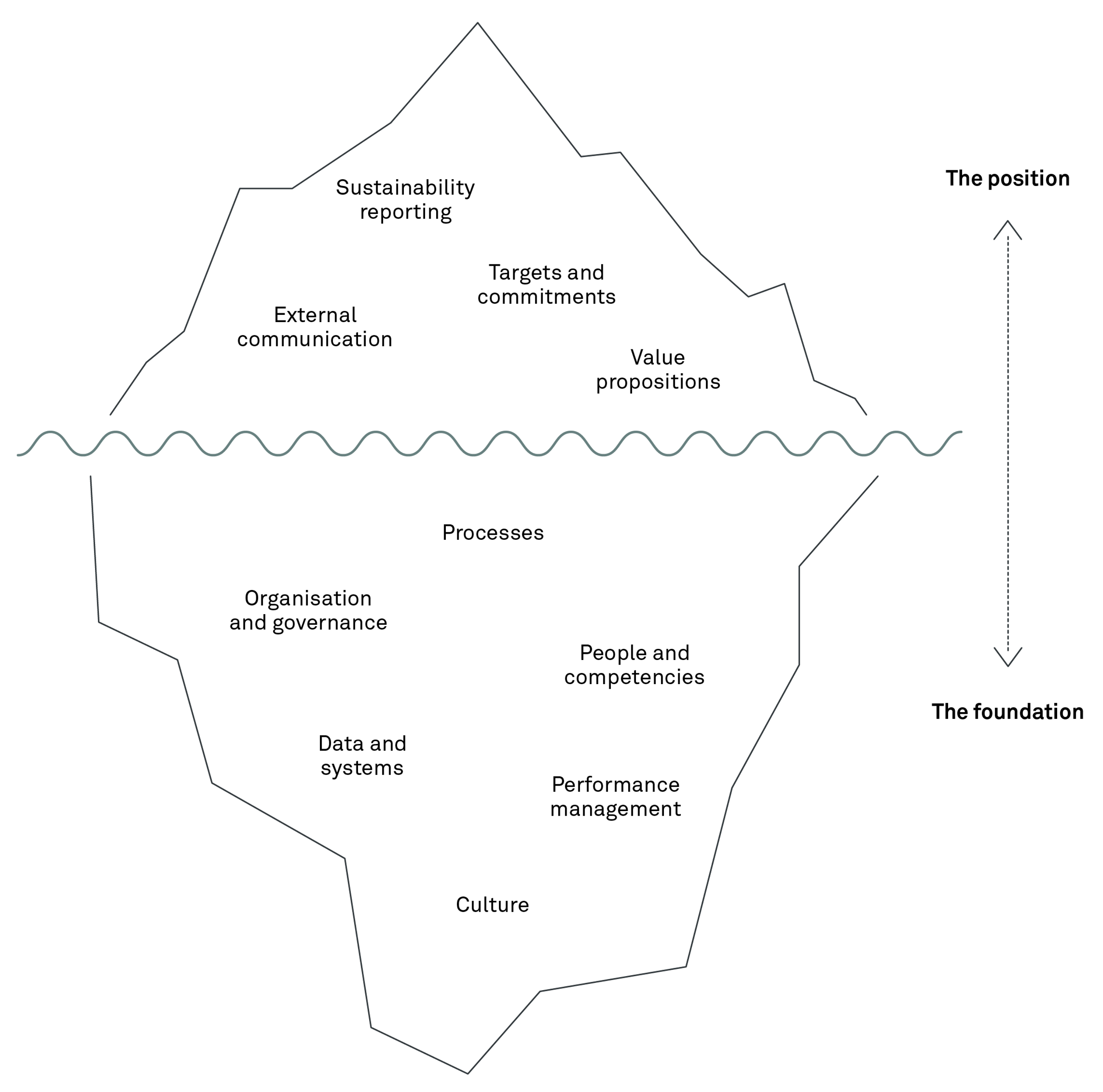Going deeper and embedding sustainability into core operations
21 March 2025
Companies struggling to succeed with their sustainability strategy are slowly but surely finding out that real sustainability success is not just about what is visible above the surface. This article explores how going deeper – and embedding sustainability into core operations – creates real value capable of driving competitive advantage.
At Implement, we work closely with clients on their sustainability journeys. In our experience, many organisations can feel uncertain and overwhelmed when envisioning their sustainability strategy, which often leads them to adopt a defensive approach that focuses primarily on compliance and safeguarding their reputation, rather than on what can truly set them apart and generate value.
Driven by a surge of regulatory demands and heightened stakeholder expectations, sustainability reporting is evolving rapidly. At the forefront of corporate concerns is the Corporate Sustainability Reporting Directive (CSRD), which requires detailed sustainability reporting. Recently, the landscape shifted further with the introduction of the Omnibus Regulation by the EU Commission on 26 February 2025, which amongst many things proposes reducing the number of companies obligated to report under the CSRD.
Despite these changes, integrating sustainability into the core of the organisation remains essential for maintaining competitiveness. Why? Because when organisations embed sustainability into their operations, they shift it from being seen as a cost – or burden – into a powerful lever for value creation. By incorporating sustainability into core operations, organisations unlock significant long-term value that goes beyond mere compliance. Doing so also allows them to navigate and capitalise on evolving demands effectively.
Into the hidden depths
Imagine sustainability as an iceberg floating in the vast ocean of corporate responsibility. The visible tip represents the outward, surface-level aspects of sustainability that stakeholders can easily see, reflecting an organisation’s external position in the market. However, like an iceberg, the true substance of sustainability practices lies beneath the surface, in the vast, hidden foundation that supports them. This foundation, as shown below, is composed of key dimensions that ensure the effectiveness of an organisation’s sustainability practices.
Our experience shows that organisations often place too much emphasis on external positioning, focusing primarily on surface-level aspects. However, this approach can overlook the critical need to establish a robust foundation by integrating sustainability into the core operations of the organisation. By concentrating on visible aspects (i.e. the tip of the iceberg), companies risk hindering progress in embedding sustainability into financial reporting, risk assessments, and strategic planning.
Additionally, without comprehensive sustainability data and insights, organisations may make uninformed decisions that can harm their credibility and market reputation, ultimately undermining their external positioning. To drive sustainable value and enhance overall business performance, we recommend that organisations shift their focus from external positioning to the foundational dimensions of the iceberg by integrating sustainable practices into the core of the operating model.
Integrating sustainability into the operating model
Integrating sustainability into your operating model can unlock significant value for both your business and your customers. This opportunity is reflected in numbers from Gartner, showing that 69% of CEOs view sustainability as a leading business growth opportunity, and 51% acknowledging that climate changes are prompting operational adjustment.
To maximise the potential for value creation, organisations must be ready to embrace operational change by integrating sustainability into their operating model. This involves several key areas, as reflected in the sustainability iceberg model:
- Processes: Aligning business processes with sustainability goals.
- Organisation & governance: Ensuring that governance frameworks facilitate effective sustainability management.
- Data & systems: Enhancing capabilities to track sustainability metrics and inform decision-making.
- People & competencies: Developing the necessary skills and knowledge within the workforce.
- Performance management: Implementing performance metrics and incentives that drive sustainability goals.
- Culture: Encouraging a culture of sustainability within the organisation.
Our approach to anchoring sustainability – and realising its value – involves integrating it within the organisation and fostering ownership of systems and practices. This requires a comprehensive yet, at first glance, relatively simple change management task.
Steering the change
To ensure strategic relevance and operational effectiveness, we recommend that companies take these three actions to navigate change toward the desired outcome:
- Establish sustainability baseline: Develop a thorough understanding of current operations and their double materiality, and assess governance, data, systems, and architecture. Identify key challenges and prioritise them accordingly.
- Strategise and set targets: Outline and detail the sustainability strategy and targets, identify integration areas across the value chain, and clarify the scope of the operating model.
- Design future operating model: Clarify the design of the future operating model which supports the strategic direction and achieves the defined sustainability targets, across the operating model dimensions. Understand and quantify the identified changes.
If a company has already made progress in any of these areas, it should build on those efforts rather than duplicating them.
Delivering the change
Steering the change is one thing; delivering it is another. To ensure proper ownership, engage people effectively, and realise business benefits, companies must focus on the entire flow of tasks – from planning and implementation to the ongoing maintenance of their efforts. However, trying to tackle everything at once can be overwhelming. By identifying and concentrating on the most pertinent actions, companies can integrate sustainability practices more effectively:
- Plan the implementation: Create an implementation plan that includes a change and communication plan, upskilling, and clear roles and responsibilities for managing the change.
- Implement: Implement sustainability within the operating model. Set up the technical infrastructure, establish a future-proof reporting system, build competencies for the key roles, and get the right change management to ensure lasting effect.
- Continuously measure and communicate: Ensure that the new sustainability operating model is consistently achieving the defined goals. This includes ongoing measurement of progress, performance reporting, and continuous communication to stakeholders throughout the process.
To truly succeed with a sustainability strategy, organisations must shift their focus from visible aspects to foundational elements. By embedding sustainability within the operating model, companies can foster stronger ownership and engagement, aligning systems and practices with their sustainability goals. This deep integration embeds initiatives deeply within core operations, creating a robust foundation for long-term value creation. At Implement, we guide clients through this transformative journey to make sustainability a strategic asset.





